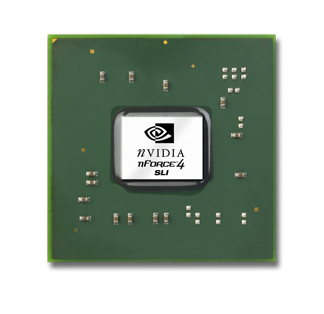nForce4: PCI Express and SLI for Athlon 64
by Wesley Fink on October 19, 2004 12:01 AM EST- Posted in
- CPUs
Index
In round 2 of the chipset wars, nVidia performed a massive transformation of the nForce3 chipset, moving from the pedestrian nForce3-150 to the leading-edge nForce3-250 family in April. As good as nForce3-250 is, however, users knew that more was on the way from VIA, SiS, and nVidia themselves. The CK8 chipset was first displayed at Computex in June. With the successful launch of the nForce3-250 family, it was clear that nVidia had every intention of upping the ante in the Athlon 64 market with both PCI Express and Dual Video cards on the single-chip CK8.
In the four months since we first saw CK8, a lot has happened in the computer industry. Intel launched their new Socket 775 processor and 925X/915 chipset and received a less than enthusiastic reception from enthusiasts. The yawns from the computer community have translated into very poor retail sales for the new Intel platform. Promised performance updates to the new Intel architecture, which were supposed to drive sales of the new 775 platform, have been scaled back, with rumors that mainstream 1066 parts now are not expected until the middle of 2005.
AMD has continued their performance push, with the introduction of the dual-channel 939 on June 1, and today, AMD extends their CPU line at the top with the FX55 and 4000+ processors. Meanwhile, Intel's top 3.6Ghz CPU is finally appearing in the retail channel more than 3 months after introduction. While Intel pioneered the move to 90nm, the transition to 90nm has been anything but smooth for Intel, with concerns about heat and the difficulty of moving the 90nm process to the top performance end of the Intel line. AMD has just introduced their first 90nm Athlon 64, which generally appears to avoid the problems that Intel encountered. However, we will not really know whether or not the shrink is a complete success for AMD until we see the top Athlon 64 processors in 90nm.
All of these developments have quickly changed the landscape of the computer market. In the retail market, AMD has moved from a small percentage of the total retail market to even with Intel in the last couple of months. Computer users who scoffed at the idea of buying an Athlon 64 computer a few months ago are now shopping for Athlon 64 computers. Also VIA, which had problems with the PCI/AGP lock in the initial launch of the K8T800 PRO, has fixed these issues with shipping chipsets. VIA also demonstrated a working K8T890 chipset a few weeks ago that features PCI Express and the promise of Dual Video cards in a future K8T890 Pro chipset. Thus far, there are no retail boards based on the K8T890 that have appeared in the market, but VIA promises that they will be here "soon".
All of these developments have changed the landscape for nVidia. In other words, the stakes for CK8 have changed since June. A winner with CK8 would change nVidia from an AMD chipset maker to one of the major players in the chipset market. nVidia seems keenly aware of what is involved and they have pulled out a whole slew of features to win you over if you're looking for an Athlon 64 motherboard.










101 Comments
View All Comments
Zac42 - Tuesday, October 19, 2004 - link
I think that it has to be two Nvidia cards with an SLI connector. You are thinking of the alienware video array, which theoretically can use two different branded cards.GhandiInstinct - Tuesday, October 19, 2004 - link
Wesley,So in SLI, I can put any two video cards together? No matter the spec difference or maker difference? New and old? Future and past?
microAmp - Tuesday, October 19, 2004 - link
I take it the SLI benchmarks from nVidia were done at about 1600 x 1200 resoultion?Wesley Fink - Tuesday, October 19, 2004 - link
Kris -Anand and I got some hands-on time with the SLI system while we were visiting nVidia. The benchmarks we ran confirmed the numbers reported for the 6800 Ultra single and SLI. The test system was an Asus SLI motherboard with a 4000+ CPU. While we did not personally run benchmarks with the 6600GT SLI or the 6800GT SLI we have no reson to doubt nVidia's numbers based on what we did confirm.
The Reference board is NOT SLI, which is why SLI testing was limited to our time with nVidia.
KristopherKubicki - Tuesday, October 19, 2004 - link
#6 those are NVIDIA's benchmarks, not actual 3rd party confirmed benchmarks.Kristopher
Wesley Fink - Tuesday, October 19, 2004 - link
#2 and #4 -SLI Performance tests are in a table on page 3. Two 6600GTs don't outperform a 6800 Ultra, but they do outperform a 6800 GT.
ksherman - Tuesday, October 19, 2004 - link
#4, from what ive heard, it is probablyh likely that two 6600GTs would definetly cream the 6800 ultra. I do agree that we need some SLI benchies!!!ariafrost - Tuesday, October 19, 2004 - link
*Drool* Anyone know how much of a performance boost would come from SLI yet? I'm wondering if two 6600GTs would outperform a 6800 ultra.glennpratt - Tuesday, October 19, 2004 - link
Page 2"While nVidia was not ready to ship nForce4 SLI reference boards for review, they were demonstrating a major manufacturer's nF4 SLI board with a pair of nVidia 6800 Ultra video cards. We also got to play with the SLI system with an Athlon 64 4000+ CPU, confirming benchmarks that were supplied by nVidia."
Jincuteguy - Tuesday, October 19, 2004 - link
why didn't anand did any SLI performance test? i thoguht this board suppose to have SLI.